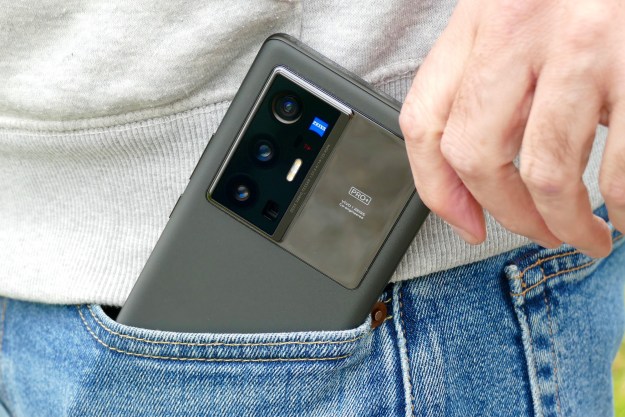
“A stunning design, plenty of tech, and a cracking camera can’t save the Vivo Nex S from its frustrating software.”
- Great design
- In-display fingerprint sensor works well
- Pop-up camera is a fun, eye-catching feature
- Rear camera takes great pictures
- Software frustrates
- Import only
- No Google services installed
The argument that smartphones all look the same has become slightly less convincing in 2018, with the release of visually different, exciting phones from several manufacturers. Interestingly, the cutting edge designs mostly originate in China, with the Xiaomi Mi Mix 2S, the Oppo Find X, and the Vivo Nex S — the subject of our review — all turning heads this year.
Unusually, we saw the Nex S as a concept device called the Apex earlier this year, but we didn’t expect the phone to go on sale so soon in almost exactly the same form. Not only did the Apex become a phone that we can all buy (kind of), but it went through some key changes that improved on the concept. We’ve been using the phone for a while, and it feels very much like the future of smartphones.
Before we get started, it’s important to note the Vivo Nex S is only available in China, and eventually in select other regions. It does not have an official U.S. or U.K. release date, and while it’s possible to import the phone, our review device did not come with Google services installed, like the Google Play Store.
Minimalist design, and a massive screen
Just look at it. The Vivo Nex S is really one of the most attractive phones we’ve seen in ages. It’s devoid of things we’re used to seeing on smartphones today — the visible fingerprint sensor and the display notch primarily. The Vivo Nex S has neither, but not at the expense of the features they enable.
The 6.59-inch screen covers almost the entire front of the phone, yet its footprint is barely larger than the Google Pixel 2 XL, giving the Nex S a 91.2 percent screen-to-body ratio. There is still a slight chin. The back of the phone is smooth, uninterrupted by a fingerprint sensor, and there isn’t one on the front either. Instead it’s an in-display sensor, something Vivo has pioneered in the industry. The Vivo Nex S showcases how fantastic simple design can look, when unencumbered by sensors, cutouts, and excessive branding. It still finds space for a 3.5mm headphone jack too.
The Vivo Nex S is really one of the most attractive phones we’ve seen in ages.
The screen is what we’d call screen-shaped, without a notch (like on the iPhone X) blighting the straight simplicity of the top edge. The sensors are hidden, and the speaker is under the display, while the selfie camera is inside a motorized module that glides out the top of the phone. It’s the Nex’s party trick, and it simply doesn’t get old. Everyone, without fail, that we showed it to loved it. It’s fun, different, space-age, and a neat solution to a problem that currently forces the use of a notch.
The 6.59-inch Super AMOLED screen has an unusual 2,316 x 1,080 pixel resolution, with a 19.3:9 aspect ratio. The bezels are tiny, with 1.71mm at each side, 2.16mm at the top, and 5.08mm on the chin. Because it’s AMOLED you get deep blacks, great contrast, and decent visibility in sunlight. It’s not very bright though, and we tended to keep the brightness at maximum without the auto assistance turned on.
Flip the phone around and there are some great details. The rear panel has an intricate, laser-etched holographic design under the surface that shines in all the colors of the rainbow when it catches the light. We’re glad it’s there, because the phone is so minimalist, it runs the risk of being faceless — when the camera is hidden away — without this welcome flair. Even the antennas are hidden mostly from view.

Downsides? A textured button on the left of the phone activates the onboard Vivo AI, which is all in Chinese, and we didn’t find a way to remap it. This is also a big phone, with a monstrous screen on the front. This presents a problem for those without similarly gigantic hands. Plus, the almost complete lack of bezels means the keyboard can often feel very low, and we often missed keys in the lower left or right because the phone is so large and fairly difficult to hold.
It’s also difficult to tell which way is up, so when picking the Nex S up it’s often the wrong way round. It’s quite heavy at 199 grams, and the case that comes with it is made of a material that grips fabric, making it hard to get out of your pocket. We’re concerned over fragility — this is a very big, heavy, glass phone. The sticky case is a necessity.
Despite some of the design downsides, the more we look at the Vivo Nex S, the more we love it.
Pop-out camera
Vivo has a strong history in camera technology, but it’s arguably best known for its selfie cams. But, while the pop-up camera lens on the front is about as tricky as camera features get, the rear camera’s impressive performance has overshadowed it. How good? There have been times where we have picked up the Nex instead of the Huawei P20 Pro. The Huawei phone still has our favourite camera of 2018, but in the right situation the Nex is equally impressive.
On the tech side, the Nex has dual-camera lenses on the back — one 12-megapixel, f/1.8 lens and the other a 5-megapixel f/2.4 lens. It comes with optical and electronic image stabilization, a two-tone flash, and HDR. There are plenty of modes to keep you snapping new pictures too, including a portrait mode, AR stickers, a panoramic selfie mode, and a bokeh effect on the front and rear cameras. The camera also uses Vivo’s artificial intelligence (AI) system, called Jovi (really), for scene recognition and other tweaks.
The Nex S takes delightful, colorful, and visually exciting photos.
Take it out in the day, especially if it’s sunny, and the Nex S takes delightful, colorful, and visually-exciting photos. It’s a joy to point it at a scene and know you’re going to get a picture you’ll love after tapping the shutter release. It excels at landscapes, blue sky, and anything brightly colored. Low light is good too, although it does tend to turn dark skies very blue. Thankfully, there’s a lot of detail in the shots to make up for it.
When the AI mode activates, it does make a difference to the final image, although opinion on whether it improves the shot will be divided. It often added a relatively aggressive HDR filter-style look to shots. Sometimes we liked it, other times not so much. Dig into the settings and you can turn off the AI.
What about the selfie camera and the pop-up module? First, don’t worry about the speed. It’s always up and ready to go when you need it. Second, don’t worry about the module’s strength. It’s so solid, Vivo made a promotional video with the extended camera on multiple Vivo Nex phones holding a sheet of glass up, on which a ballerina stood and danced. It doesn’t wobble about, and when you push it down it takes a degree of force to get it to automatically retract.
There’s plenty for selfie fans to enjoy. The beauty mode has six degrees of aggressiveness, but we’d choose the AI mode to tone down the effect, otherwise it overexposes and turns skin very white. The AR stickers are cute additions like you’d expect to find in Instagram or Snapchat, and the panoramic mode helps take group shots. We quite liked the pictures it took, but with the beauty mode on, they’re far from realistic. The camera shutter can be slow too.
Security and performance
Let’s talk about the Nex’s in-display fingerprint sensor. It’s in the central, lower-third of the screen and it falls easily to thumb when you pick up the phone. We registered various fingers on different occasions, and found the thumb is most convenient. It requires a light touch to operate. Press too hard, like you may on another sensor, and it won’t work. Press too lightly, and it may not “see” your finger. Once you get the feel it’s very reliable, but definitely slower than other traditional sensors.
Once you get the feel it’s very reliable, but definitely slower than other traditional fingerprint sensors.
Activating the double tap to wake option helped with usability, as there’s nothing to “feel” in the dark, and the graphic to show you where the fingerprint sensor is located doesn’t always appear when you want it to. It’s considerably better than the experience we had on the Porsche Design Huawei Mate RS, and therefore stands as the best in-display fingerprint sensor we’ve used yet. The Nex S does not have face recognition, leaving the in-display fingerprint sensor as your one and only security measure.
The Nex S has its speaker for calls under the screen, like we’ve seen before on the Xiaomi Mi Mix. It works in the same way, sending vibrations through the display and into your ear when you hold the phone up to your head. We never heard any real difference in quality between the Nex S’s speaker and the more traditional one used on other phones.

The Vivo Nex S is a high performance machine with a Snapdragon 845 processor and 8GB of RAM, which is about the best you can get at the moment. Browsing the web, using apps, sending emails, messages, and tweets are all effortless. The Vivo Nex S is a real powerhouse, and even with the less than ideal software, it didn’t slow down.
Here are a few benchmark tests. We didn’t include AnTuTu, because the app wouldn’t install.
- Geekbench 4 CPU: Single-core: 2,402; multi-core: 9,137
- 3DMark Sling Shot Extreme: 3,678 (Vulkan)
These are impressive, and surpass phones like the Galaxy S9 Plus and the Pixel 2 XL. The Vivo Nex S can take anything you throw at it.
Tricky software
We love the Nex’s futuristic design, and the camera makes it a desirable companion. Sadly, things take a downturn when we talk about the software, some of which is Vivo’s fault, and others less so. The Nex S is sold in China and our review device was supplied by Vivo. It comes with Vivo’s own Funtouch user interface over the top of Android 8.0, but it did not have any Google services installed. This makes reviewing it internationally rather challenging, as many of us rely on Google Maps, Gmail, YouTube, and access to the Google Play Store to get things done.
Even after we installed Google’s apps, we still had to deal with Vivo’s Funtouch. Or actually, not-so-Funtouch.
For this reason, we sideloaded Google’s apps and all the necessary services needed to make them work. We managed to do it, but the process was still a pain to find and load the correct apps and files. It’s not a task we’d recommend those not technically inclined to undertake. Additionally, even with everything installed, not everything worked. The Nex S would not automatically upload photos to Google Photos, for example, a task which had to be done manually. Some apps refused to install, returning error codes we’ve never seen before.
Even after we installed Google’s apps, we still had to deal with Vivo’s Funtouch. Or actually, not-so-Funtouch. The Nex doesn’t have any buttons, and Vivo doesn’t want too many virtual ones messing up its clean interface either, so it has adopted an iPhone X-style swipe navigation system. It’s divided into three sections. Swipe centrally for home, on the right for back, and on the left to show a control center for brightness, Bluetooth, volume, and quick app access. Swiping down from the top still shows notifications.
It’s not as polished as the iPhone X, and anyone coming from a regular Android phone will have to spend time learning its nuances. Because the phone is made for China, we’d also often get alerts and notifications from apps and services in Chinese, making the phone feel less friendly and like our own. Jovi, the Nex S’s AI assistant, is all in Chinese so we couldn’t use it. If you love to dig around and customize your phone, there is a wealth of features inside Funtouch, from a quick access shortcut that stays permanently on screen, to a split screen mode, gesture controls, and a double tap to wake.
To Vivo’s credit, the phone received regular updates over the few weeks we’ve been using it, adding a few features and fixing bugs elsewhere. Coping with unfamiliar software is a part of the deal when you import a phone from China. Funtouch is fast and smooth most of the time, but it’s very different to the user experience on a Samsung, LG, or any other Android phone we can buy from a carrier. It’s also very different to stock Android on a Google Pixel or Android One phone.
Two-day battery life, with quirks
A 4,000mAh battery gives the Vivo Nex S strong standby times for a flagship, premium phone. We’ve had two days of regular and average use, but judging long term use is harder because power consumption has been erratic. We put this down to the software, which includes many apps with which we are unfamiliar, and may be sucking power without us knowing. In just a few hours one afternoon, we lost 30 percent battery with just a short gaming session and basic operation.
Price, availability, and warranty information
The Vivo Nex has been announced for China, and it will also be released in India, Russia, Hong Kong, Malaysia, and Taiwan. It has not been officially announced for the U.S. or the U.K., but Vivo could eventually decide to do so. The price in China is 3,900 yuan, which converts over to around $600. It’s possible to import a Vivo Nex, with GearBest selling the phone for $710 at the time of writing. Other importers will provide a similar service and price. This also means the warranty support will vary, as it will depend on the company you decide to import the device from.
The Vivo Nex S operated without a problem on a U.K. 4G LTE network, and has a wide array of bands for worldwide network compatibility. However, it’s not guaranteed to always connect to the fastest GSM signal in the U.S., so do keep this in mind if you decide to import one.
Our Take
A stunning technical marvel that frustrates on a software level, and annoys because we can’t easily buy one.
Are there any alternatives?
Yes, although you’ll have to make some concessions. If you want a phone that has a pop-up selfie camera, you’re out of luck aside from the Oppo Find X, which is another import phone. If you want an in-display fingerprint sensor, the Porsche Design Huawei Mate RS is about your only other choice. Both together, it’s the Vivo Nex S or the Oppo Find X.
If you want a high performance phone with a great design, and a strong camera, then the field opens up a lot more. The Samsung Galaxy S9 Plus probably comes closest to the look and ability of the Vivo Nex S, along with the Google Pixel 2 XL. You also get the same chip and amount of RAM in the OnePlus 6, and an equally slinky design. The great thing about choosing any of our best smartphone recommendations is they come with a much more familiar version of Android, and it’s the Pixel 2 range we’d recommend for the best version.
How long will it last?
The Vivo Nex S is not water resistant, is made of glass, and is quite heavy. It’s a disaster waiting to happen for the clumsy. It is incredibly well made and very solid, so we have no concerns over the device itself not lasting the course of normal ownership. Vivo has also been good at delivering software updates, but we don’t expect that to include an upgrade from Android 8.1 to Android P in a timely manner. It’s just not that important in China, where the phone is likely to sell in large numbers.
Should you buy one?
No. Unless you live in China, the software experience will frustrate compared to more readily available Android smartphones. This is a disappointment, because the rest of the phone is great, and even the price is competitive considering the cutting-edge technology inside. However, if you’re comfortable installing Google Play Services on import phones, and don’t mind messing around with a phone in this manner, you’ll be the envy of many with the Vivo Nex S in your hand.
Editors' Recommendations
- 2MP phone cameras aren’t going anywhere any time soon
- Vivo’s V23 5G looks quite a lot like the iPhone 13
- Vivo Watch 2 to launch December 22 in China as company’s first eSIM wearable
- 4 big names commit to MediaTek’s Dimensity 9000 chip for flagship phones
- Vivo’s new Origin OS to launch December 9 with tons of new features






























